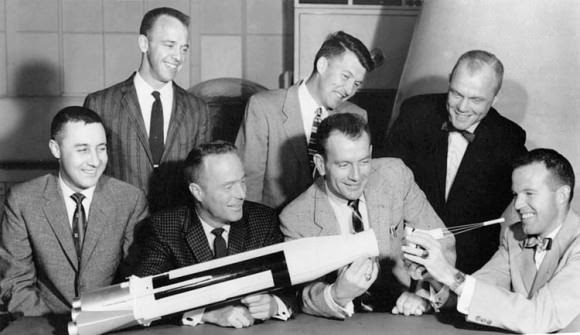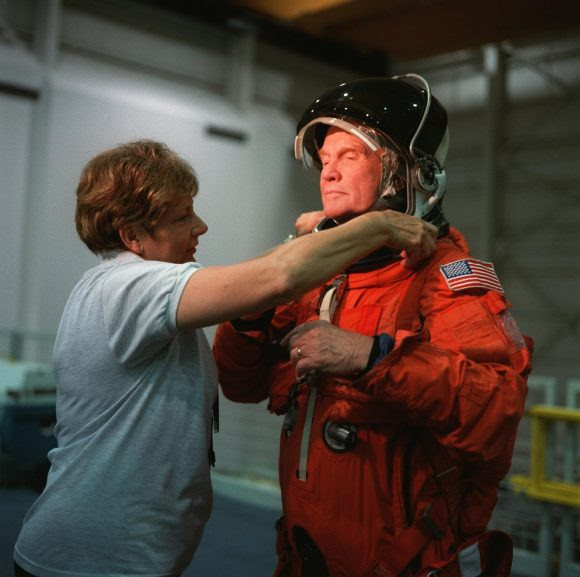John Glenn always had the right stuff.
Glenn, the first American astronaut to orbit the Earth and a legendary figure around the world, has died. Glenn, 95, was the last remaining Mercury astronaut, the first group of US astronauts. He flew on Friendship 7 on Feb. 20, 1962, and later flew on the space shuttle in 1998 at age 77, becoming the oldest astronaut to fly in space. He also spent 24 years as a U.S. Senator from Ohio, and had a run for the presidency.

Astronaut John Glenn views stencilling used as a model to paint the words "Friendship 7" on his spacecraft. Credit: NASA
"With John's passing, our nation has lost an icon and Michelle and I have lost a friend,” said President Obama said in a statement. Obama added that Glenn's flight pioneering flight "reminded us that with courage and a spirit of discovery there's no limit to the heights we can reach together."
"On behalf of a grateful nation, Godspeed, John Glenn."
"John spent his life breaking barriers, from defending our freedom as a decorated Marine Corps fighter pilot in World War II and Korea, to setting a transcontinental speed record, to becoming, at age 77, the oldest human to touch the stars," Obama said. "John always had the right stuff, inspiring generations of scientists, engineers and astronauts who will take us to Mars and beyond — not just to visit, but to stay."
Glenn, born on July 18, 1921, was described in statement by his family and Trevor Brown, dean of the John Glenn School of Public Affairs at Ohio State University, as "humble, funny, and generous." And "even after leaving public life, he loved to meet with citizens, school children in particular. He thrilled to music and had a weakness for chocolate."
Glen married his childhood sweetheart, Annie Castor, and studied at Muskingum College in Ohio. Glenn became a Marine Corps fighter and flew 59 combat missions during World War II and 90 in the Korean War.
Glenn attended Test Pilot School at the Naval Air Test Center, Patuxent River, Md. After graduation, he was project officer on a number of aircraft. In July 1957, he set a transcontinental speed record from Los Angeles to New York -- 3 hours and 23 minutes. It was the first transcontinental flight to average supersonic speed.
Glenn accumulated nearly 9,000 hours of flying time, about 3,000 of it in jets.
The ‘space race’ began when the Soviet Union launched the first satellite, Sputnik, in 1957. After a series of failures for the US space program, they finally succeeded on February 1, 1958 when Explorer 1 became the first US satellite in space.
But the main goal was to send humans to space.

The original seven astronauts pose with an Atlas model July 12, 1962. The 'Mercury Seven' astronauts pose with an Atlas model on July 12, 1962. Front row, left to right: Gus Grissom, Scott Carpenter, Deke Slayton and Gordon Cooper. Back row: Alan Shepard, Wally Schirra and John Glenn. Credit: NASA
In 1959, when the newly-formed National Aeronautics and Space Administration searched for the first Americans to fly in space, it focused on military test pilots. Glenn was in the select group – known as the Mercury 7 -- who was chosen.
Glenn was assigned to the NASA Space Task Group at Langley, Va., in April 1959. The Space Task Group was moved to Houston and became part of the NASA Manned Spacecraft Center (which is now Johnson Space Center in Houston) in 1962.
While Glenn wasn’t chosen for the first Mercury space flight, his flight is well-remembered for being the first American to orbit Earth. But before any US astronauts could be launched into space, history was made on April 12, 1961 when Russian cosmonaut Yuri A. Gagarin became the first human in space when he completed his successful orbital flight aboard Vostok I.
Prior to Glenn’s 4-hour, 55-minute flight in Friendship 7, Glenn had served as backup pilot for astronauts Alan Shepard, the first American in space who flew on May 5, 1961, and to Virgil "Gus" Grissom, who followed Shepard on another suborbital flight on July 21, 1961.
On Feb. 20, 1962, Glenn launched from Cape Canaveral on Friendship 7, circling the earth three times. He became a national hero.
"Roger, liftoff, and the clock is running. We're under way," Glenn said after launch. After reaching space he said, "Zero-G and I feel fine. Man, that view is tremendous."

Then-Senator Glenn joined the STS-95 Discovery crew in 1998, becoming the oldest person to fly in space at 77. Credit: NASA
Glenn was awarded the Presidential Medal of Freedom in 2012.
"The last of America's first astronauts has left us, but propelled by their example we know that our future here on Earth compels us to keep reaching for the heavens," Obama said.
|
Friday, December 9, 2016
John Glenn: Godspeed and Rest in Peace
Subscribe to:
Post Comments (Atom)
ENERGY NEWS
Oil prices rally on geopolitical tensions April 10 (UPI) -- Geopolitical factors spilled over into the broader economic mood early ...
-
19-Feb-2017 Rigor and Reproducibility Policy One Year Later:How Has the Biomedical Community Responded? Leonard P. Freedman, PhD, pre...
-
© AFP 2017 / Valery Hache MOSCOW, Dec 21 - RIA Novosti . People are most interested in sex on New Year, Christmas and...
-
Dogs are manipulated for the benefit of people, scientists have found 14:43 03/12/2017 0 33026 China said the progress in the...
-
13-Feb-2017 Researchers Identify “Achilles’ Heel” of Key Anti-Cancer Protein Researchers at Cold Spring Harbor Laboratory in New York...
-
China leads potential for tech breakthroughs: KPMG 2017-03-12 16:56:39 Long March-7 Y2 ready for launch of Ch...

No comments:
Post a Comment